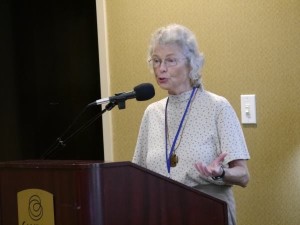“Lady Wisdom and Her Prophets,” presentation by Reta Halteman Finger at Christian Feminism Today Gathering

Dr. Reta Halteman Finger, one of the founders of the Christian feminist movement, gave an enlightening presentation, titled “Lady Wisdom” and Her Prophets,” at the Christian Feminism Today Gathering in Indianapolis.

Reta played a big part in my feminist awakening. For 15 years she served as editor of the groundbreaking newsletter Daughters of Sarah. During these years Daughters of Sarah nurtured and empowered my developing feminism. I still resonate with the newsletter’s statement of identity: “We are Christians. We are also feminists. Some say we cannot be both, but for us Christianity and feminism are inseparable.”
Through her teaching and writing, Reta continues to be a prophetic voice for gender equality and other justice issues. For many years Reta taught Bible, mostly New Testament, at Messiah College and currently teaches at Eastern Mennonite University, specializing in life in the early church. Her books include Roman House Churches for Today: A Practical Guide for Small Groups; Of Widows and Meals: Communal Meals in the Book of Acts; and Wisdom of Daughters: Two Decades of the Voice of Christian Feminism. She is currently a contributing editor for Sojourners magazine. For Christian Feminism Today she writes a blog called “Reta’s Reflections: Bible Studies from a Christian Feminist Perspective.”
 At the Christian Feminism Today Gathering, Reta gave the first plenary presentation. She set the stage by illuminating the Gathering theme, “Prophets in Every Generation,” and the theme text:
At the Christian Feminism Today Gathering, Reta gave the first plenary presentation. She set the stage by illuminating the Gathering theme, “Prophets in Every Generation,” and the theme text:
“Although Sophia is but one, she can do all things, and while remaining in herself, she renews all things; in every generation she passes into holy souls and makes them friends of God, and prophets” (Wisdom of Solomon 7:27, NRSV).
Drawing on her expertise as a scholar and teacher, Reta begins with the literary and historical contexts of this theme text. “Ancient texts need literary and historical contexts,” Reta says. “If we don’t understand context, we will get a lot of things wrong—which is an important reason why there is so much disagreement among Christians. All texts have an agenda, a slant, a perspective in order to make particular points to a particular audience.”
The Wisdom of Solomon was probably written in Alexandra, Egypt, probably between 30 BCE to 30 CE. Although traditionally attributed to Solomon, the author was likely a teacher in a Jewish synagogue centuries after Solomon’s death. It was written in Greek, and Wisdom is called Sophia (Greek word for “Wisdom”). The Wisdom of Solomon is one of the intertestamental books not included in most Bibles because it was written in Greek, not Hebrew, and thus not included in the Jewish canon. But the Wisdom of Solomon, along with the other intertestamenal books, was included in the Bible of the early Christians.
The Wisdom of Solomon takes its place among other biblical wisdom writings such as Proverbs, Ecclesiastes, Song of Solomon (Song of Songs), and some of the Psalms. The literary forms of these wisdom writings include poems, aphorisms, and instructions. The Wisdom of Solomon uses Greek modes of expression to set forth Jewish theology, giving Jews confidence in their faith under oppression in Egypt.
After giving this background, Reta moves on to explore the prophets of Sophia “in every generation,” mentioned in the theme text. She explains that a biblical prophet was one who had such a direct line to God that she or he could claim to speak for God. “A true prophet of Yahweh was always on the side of justice,” Reta says. “The problem is that the religious leaders didn’t recognize a good prophet when they got one. Listen to Jesus’s lament from Luke 13:34: ‘Jerusalem, Jerusalem, the city that kills the prophets and stones those who are sent to it! How often would I have desired to gather your children together as a hen gathers her brood under her wings, and you were not willing.’ Prophets, men or women who speak truth to power, are not usually appreciated.”
But Reta encourages us to take heart because Sophia continues to make prophets. “Not long after The Book of Wisdom was written, we have accounts of the resurrection of Jesus and the coming of God’s Spirit-Sophia,” Reta points out. “As Luke writes in the book of Acts, on the day of Pentecost, She comes to a group of men and women in an upstairs room in Jerusalem. Later, when Peter addresses a large crowd of Jews from all over the Roman Empire and Middle East, he explains what has happened. He uses the ancient words of the prophet Joel, ‘In the last days, it will be, God declares, that I will pour out my Spirit upon all flesh, and your sons and daughters shall prophesy,…Even upon my slaves, both men and women, in those days I will pour out my Spirit-Sophia. And they shall prophesy’” (Acts 2: 17-18).
My favorite part of Reta’s presentation was what she calls “Sophia, the Androgynous Christ, and Real Women.” Reta challenges us “to keep reminding our church leaders and congregations of the important truth” that “a number of New Testament writers portray Jesus as the incarnation of Sophia.” For example, in the Prologue to the Gospel of John the similarities between Lady Wisdom in Proverbs and Logos (usually translated “Word”) are unmistakable. To the Greek-speaking Jewish reader, Logos would have been interchangeable with Sophia, so John 1:1 can be translated: “In the beginning was Sophia, and Sophia was with God, and Sophia was God.”
The Gospel of John, Reta further points out, records many instances in which Jesus does not act like the oldest son in his family but more like an idealized wife and mother in a patriarchal society:
• When Jesus cleanses the temple, he is the wife furiously housecleaning and attending to the economic affairs of the household. (John 2:13-26)
• Jesus performs wifely duties when the wine runs out at the wedding at Cana. (John 2:1-10)
• Jesus makes lunch and distributes the bread and fish to 5000 people. (John 6:1-14) “Here he is Mother Jesus feeding her children,” Reta comments.
• “Speaking with Nicodemus, Jesus insists that we cannot enter God’s reign unless we are born from the womb of Spirit-Sophia.” (John 3:1-8) In an article in Sojourners titled “Mother Jesus,” Reta challenges people who resist thinking of God as other than male to consider this important image of the Spirit giving birth: “How can they overlook this very maternal activity of God’s Spirit?”
• Jesus declares that he is the bread of life and promises eternal life to those who eat his flesh and drink his blood. (John 6:48-58) “To Jews, drinking blood is strictly forbidden. So this only makes sense if Jesus is like a pregnant mother who feeds the fetus with her flesh and blood, and who breast-feeds after the child is born.”
• Jesus calls his disciples “little children” when he tells them he is going away and they can’t come along. (John 13:33) He comforts them by comparing their pain to that of a woman in labor, who later will forget the pain because she has brought a child into the world. (John 16:21-22)
• Jesus washes the disciples’ feet. (John 13:3-15) In this patriarchal culture washing feet was the job of women and/or slaves, Reta explains: “No man who wasn’t a slave would ever lose dignity by kneeling down to wash other people’s dirty feet. That was the job of the wife to do for her husband and for other guests, unless she had a slave to help.”

• “In the last chapter of John, we find the risen Mother Jesus back at work cooking breakfast for her children, the disciples who had been fishing all night without success.” (John 21: 4-13)
Reta then connects this depiction of “Mother Jesus,” the Androgynous Christ,” to women in the Gospel of John who play essential roles in an otherwise male-dominated society:
• Jesus’s mother knows more than he does about the embarrassing situation of inadequate wine for a wedding. (John 2: 1-10)
• Jesus spends more time talking theology to a Samaritan woman than to anyone else in the entire Gospel. (John 4:7-30)
• Martha plays the prominent part of identifying Jesus as Messiah. (John 11:17-27)
• Mary Magdalene is the first witness of the resurrection of Jesus. (John 20: 1-18) “The highest honor is accorded to this disciple, Mary Magdalene, as the first person to meet the risen Jesus. She then becomes the apostle to the apostles.”

Reta concludes her presentation by emphasizing that the Gospel of John combines “a human Jesus who incarnated the feminine figure of Wisdom-Sophia with characterizations of actual human women who became prophets in their generation and passed on these prophetic gifts to the next generation and continue to do so in our own lives.”


Wow, that was fantastic and illuminating! Thank you!
Thank you, Colette!